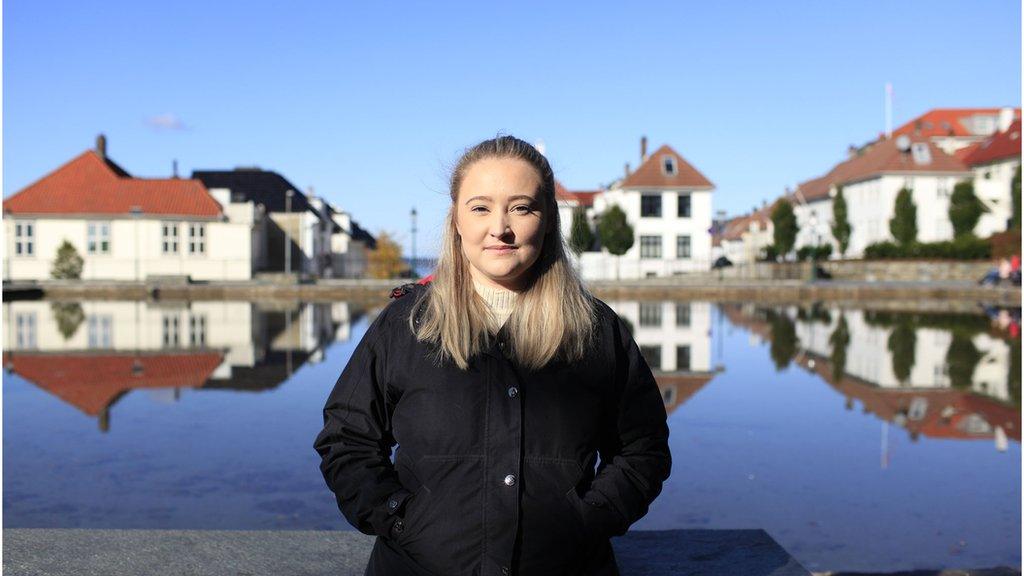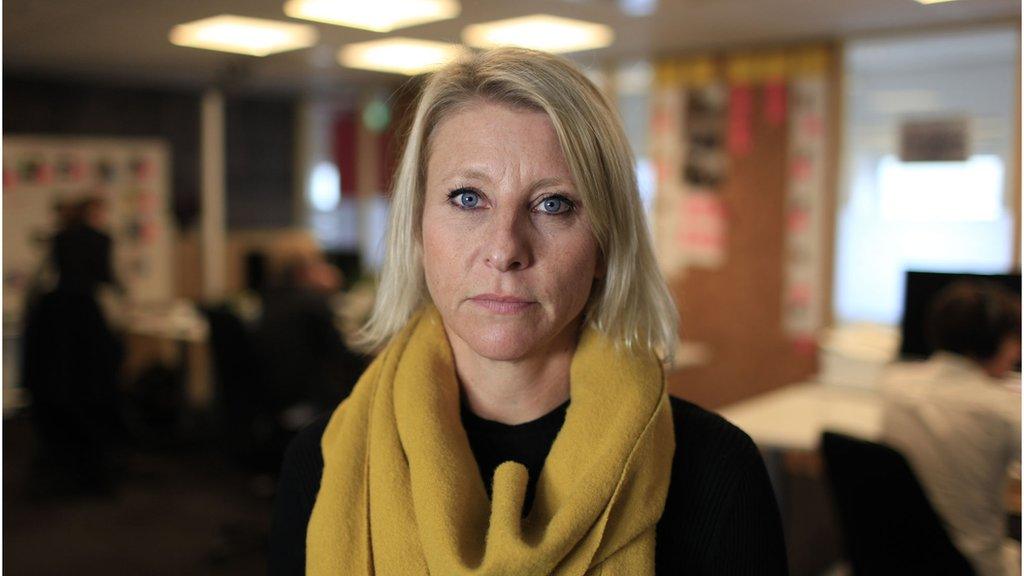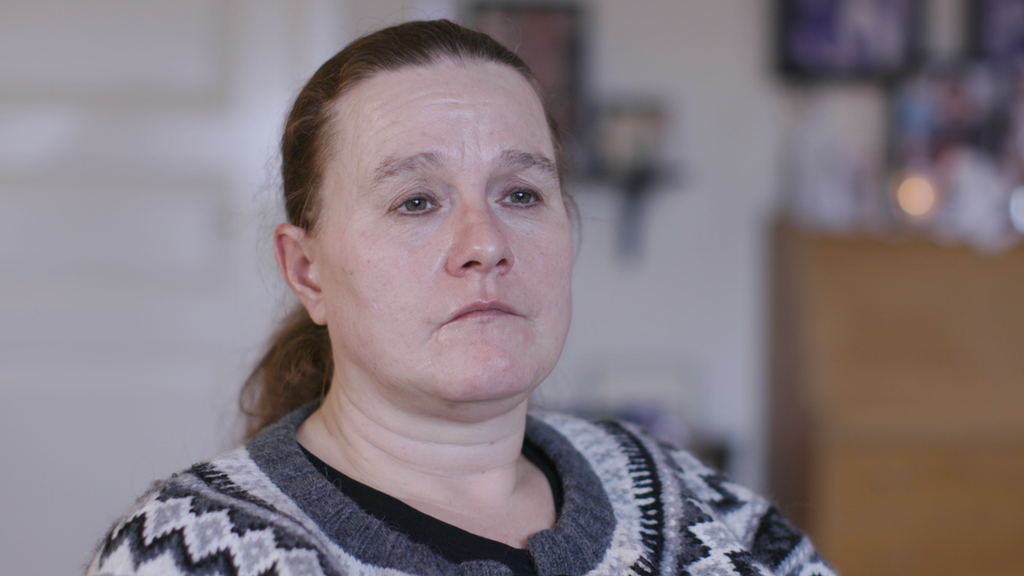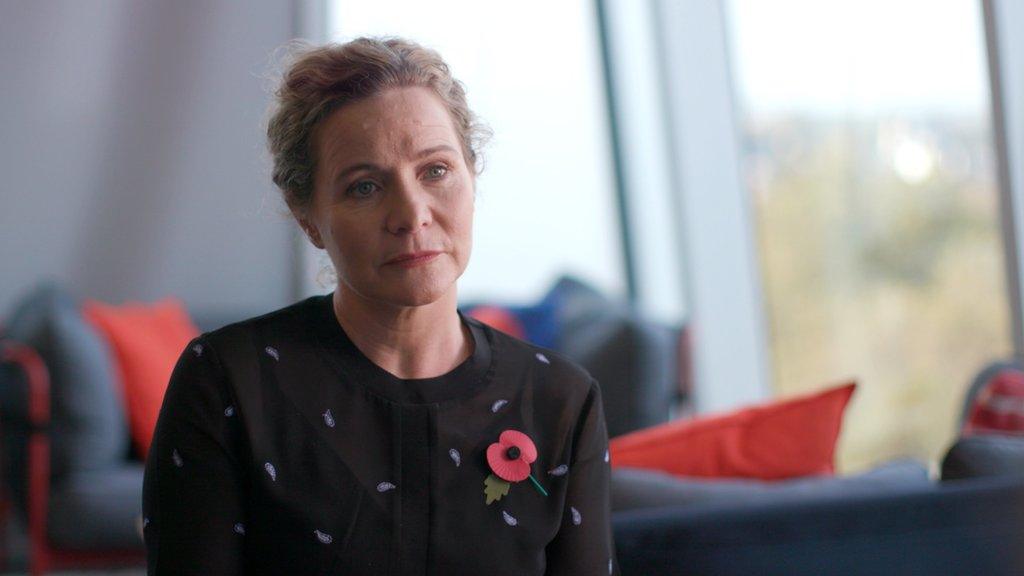The woman who tracks 'dark' Instagram accounts
- Published

Warning: Contains graphic content
Scrolling through the Instagram feed on her phone, 22-year-old Ingebjørg Blindheim explains why she has been given the nickname "the lifeguard".
"I see a lot of people who want to die," explains the young Norwegian.
"I'm not just going to watch someone saying they're going to kill themselves and ignore it and hope for the best."
Intervening to help suicidal Instagram users is not a role Ingebjørg would have chosen for herself. She doesn't work for the social media site, and she isn't paid for what she does. Nor is she formally qualified to offer help, having received no training in mental healthcare. Instead she feels compelled to act, realising she's often the last chance of help for those posting their despair online.
"I feel like when I'm not on the phone watching, people might do something to themselves and no-one will see," she says.
This means monitoring Instagram constantly, identifying those who are close to the edge and alerting the police and ambulance services. She admits to having sleepless nights. She knows that being so distracted by her phone can anger her family and friends, but she worries that without her vigilance, someone might die.
"It goes bad, because it has done before," she says.
Ingebjørg is currently keeping track of around 450 private Instagram accounts - ones that need approval from their owners before you are allowed to follow them. Most of these belong to young women who post about their darkest feelings, though there are a few boys as well. It's a secretive world of private thoughts, images and confessions, governed by an unwritten "no snitching" rule.

Seventeen-year-old Andrine was a member of one Instagram network when she took her own life
When she calls the police, she is careful not to say too much about the community for fear of alienating its members. She often feels like a detective, scrabbling around to find out as much information as she can about an anonymous user to pass on.
The reaction she receives from professionals is mixed. Sometimes she is thanked for acting, other times she is disbelieved. Earlier this year, Ingebjørg says she tried to get police to intervene in a case where a girl said she was going to take her own life. She says officers said the girl had threatened to do it 16 times before and they didn't believe her. But she says the next day, they called Ingebjørg to tell her the girl had gone through with her threat.
"I begged them to check up on her to see if she was OK, and they didn't take it seriously," Ingebjørg says.

Find out more

The Norwegian knows the power of online sharing from her own personal experience. As a young teen, struggling with an eating disorder, she began to follow Twitter accounts where others posted openly about their anorexia or self-harm.
"I saw they got a lot of attention from people who understood and cared and I wanted the same because I didn't feel that I belonged with my friends," she says.
This support is what users feel is the positive side of online communities. Ingebjørg says they can be a place to feel heard and be understood when others, especially adults and health care professionals, may sometimes appear dismissive or judgmental.
But these Instagram networks are anything but safe spaces. Whatever good some people find in them is outweighed by the bad, Ingebjørg says.
There is a reward for posting extreme thoughts and images - the darker the thought, the deeper the cut, the more likes and attention you receive, she says. They can foster a sense of competition, and act as a how-to manual for ways to harm or even kill yourself.
"I think the communities make people worse because they give you ideas on how you can kill yourself, how you can starve yourself, or get rid of the food you eat, and how you can hide your illness from people," Ingebjørg says.
After she posted pictures of her own emaciated body on Twitter, Ingebjørg was contacted by a therapist who warned her the images were encouraging others.
She says self-harmers she knew moved from Twitter to Instagram as it was easier to hide what they were posting from people they didn't want to see the content.
Four years ago, Ingebjørg and her 15-year-old best friend were both being treated as in-patients for their mental health issues.
Both were discharged around the same time. Ingebjørg was confident that she would get better, but her friend threatened to take her own life if she was sent home. The girl posted a picture of rail tracks prompting Ingebjørg to call her, pleading with her to stay safe. Her friend reassured her she would, but hours later Ingebjørg received news of her death.
"That's why I'm doing the things that I do," says Ingebjørg.
"I promised myself that after I lost my best friend, I would do anything I could to prevent people from having to feel the feeling I had when it happened," she says.

The investigator
While Ingebjørg monitors her Instagram network from her home in Bergen, across Norway, in the capital Oslo, an investigative journalist has also been following the closed, disturbing world.
Annemarte Moland works for the state-owned broadcaster NRK. She first came across the online community a year ago when she travelled to a small Norwegian town to research a story about three teenage girls who had killed themselves. One of the girls had a private Instagram account where she had shared thoughts of suicide and self-harm.

"The police told me she had a 100 followers across the country, but they didn't do anything more with it," Annemarte says.
"I thought, this is strange. A hundred followers? Who are these people?"
After the story had been published, Annemarte was approached by a young woman who told her that there were at least 10 other girls in the same Instagram network who had also taken their own lives.
Realising she had stumbled across a far bigger story, the journalist tried to make contact with the secretive network. At first she set up a dummy profile using dark, gloomy but non-violent images to connect with other girls.
Annemarte was surprised at how quickly Instagram recommended dozens of profiles for her to follow, which were sharing self-harm and suicide material.

'I lost my daughter'
The journalist moved on to trying to confirm the suicides she had been told about, tracking down and calling family members. This led her to Heidi whose daughter, Andrine, had killed herself two years before, just before her 18th birthday. When Heidi said she still had her daughter's mobile phone, but hadn't touched it since her death, Annemarte realised she might have found a way into the network.
"Heidi said, "I've always known there is something on the phone I don't want to see"," says Annemarte, recounting the story.

At the time, Annemarte was in her office in Oslo and Heidi was at home in the city of Tromso, in Norway's far north. Annemarte advised her not to open the phone alone, but Heidi felt compelled to go ahead. She knew her daughter had had a secret Instagram life because some of her online friends had been in touch since her death. But she wasn't prepared for the graphic images that Andrine had posted.
"Heidi called me back and told me that Andrine had killed herself online," says Annemarte.
"She documented it - like, every second of her suicide."
Soon after, Heidi travelled to Oslo to go through Andrine's Instagram accounts together with Annemarte.
"I found pictures, videos, text. Some were very funny. In some it was so good to see her alive because she was so joyful and she showed that part of her as well as the sad side," says Heidi.
But other posts were heartbreaking to watch, like one showing nothing but a black screen to the sound of Andrine's crying. Heidi found pictures of serious self-harm and videos in which Andrine said she couldn't take it anymore and wanted to die. The hardest posts to see were the ones that documented the last hours before Andrine's suicide.
"It was almost like she was screaming her death," Heidi says.
From Andrine's phone, Annemarte began to build up a picture of how many other young people were inside her dark Instagram network.

Suicide network
Andrine had around 130 followers, which Annemarte says is typical for a Norwegian account. By looking at the followers of Andrine's followers, the journalist was able to identify 26,000 accounts in total. From here she removed all the accounts that were public, bringing the number down to 5,000. She further narrowed down her search by focusing only on accounts that used depressive imagery, words or emojis.
She says she found more than 1,000 similar dark accounts, all within two steps of Andrine's profile. They included young women and teenagers in at least 20 different countries, including Denmark, Britain, Germany, Australia and the US.

By analysing these, Annemarte and her colleagues were able to identify patterns. Most of the accounts were held by girls with an average age of 19. Most had some sort of mental health issue, which ranged from feeling a bit down to severe depression and anxiety. Many had been in and out of hospital.
A graphic that NRK put together shows the network stretching out across the world like a dark spider's web, with Andrine at its centre.
Like Ingebjørg, Annemarte could see its attraction. Mixed in with posts about self-harm and death, the girls behaved like ordinary teenagers, sharing pictures of new clothes or videos of themselves dancing to music.
"There's lots of support and attention," says Annemarte.
"They all have in common that they don't believe they can get help anywhere else. So they meet up to try to help each other and support each other on their darkest days."
But the journalist could also see the network's danger. She noted how the darkest or most suicidal material received the most attention. Supporters would post heart emojis and phrases like "keep strong" or "hold on".
"I call it the upside down version of giving actual support because these are quite sick girls trying to help quite sick girls. It's sort of a reversed place," says Annemarte.
Because the network was so private, there were no outside voices moderating the content or providing helpful or professional advice. After spending time inside it, the journalist began to sense the girls were inadvertently encouraging each other to go further.
"I felt like they had been pushing each other closer and closer to the edge. But when it gets to the edge, they all say, 'Oh no, don't do it. Stay alive'," she says.
Heidi believes this kind of group behaviour would have had a significant effect on Andrine.
"I think that the community meant everything for her. It ended so badly because she was very easily encouraged by other people since she was young," she says.

Through the year-long investigation, Annemarte was able to confirm that at least 15 Norwegian girls from the network NRK mapped have killed themselves.
"They are playing with their lives," she says of the community as a whole.
"If someone cuts themselves, they get loads of hearts and likes. How can you like somebody's picture when you've cut deep through your arm?"

Instagram's response
From February this year, Instagram banned all graphic images of self-harm and restricted videos and pictures showing suicidal themes. The decision followed the death of the British teenager, Molly Russell, who took her own life in 2017 after viewing graphic content on the platform.
In the past month, the US-based company has extended this ban to include memes, drawings and cartoons that promote suicide or show suicide and self-harm methods.
But Annemarte feels these safeguards do not go far enough. Although there is less graphic content on Instagram since the ban came into place, she says the members of the network have found ways around the platform's restrictions.
"It's still on Instagram, but going more underground. It's like it's less graphic but even more suicidal," she says.
"When girls now post their suicidal attempts, they will post an illustrative image from their day-to-day life, maybe an image of them lying in their bed, and say in the text, 'This is my final day, I don't want to live anymore'."
The journalist is also concerned that the social media site continues to recommend users who post harmful content to other users - something which Instagram said in February that it would stop
"We've seen girls trying to kill themselves and on the same day being recommended to other suicidal girls. So this is how the network keeps growing," Annemarte says.
Instagram has responded by saying they recognise that mental health is a complex issue and they need to take a balanced approach.
"We fundamentally believe that there is a place on Instagram to come and express yourself, even if you're having a really tough time," says Tara Hopkins, Instagram's head of public policy for Europe, the Middle East and Africa.

"But we have to strike the right balance between ensuring that there is that space for expression, with making sure that we are keeping people protected from potentially seeing what could be really harming or disturbing," she says.
Hopkins says Instagram is constantly in touch with health experts and NGOs like the Samaritans, who have advised the company that removing all references to suicide and self-harm could further stigmatise mental health.
At the same time, she says the site uses a combination of human moderators and machine learning to identify and remove harmful material before it is reported. Hopkins says it is vital that users still report upsetting content so the company can learn from the complaints.
In response to Annemarte's concern that Instagram is continuing to recommend dangerous accounts, Hopkins says once an account is flagged, it will not be recommended to other users.
"Honestly our job will never be done because we've chosen to take a nuanced, and I think a very balanced, approach to this," says Hopkins.
"We are really deeply committed from the top down at Instagram to getting this right and to making sure that we have that balance right."
But Heidi and some other parents believe their daughters would not be dead if they hadn't used Instagram.
"When I have seen what's posted and how active Andrine was on that Instagram community, and heard what the other girls had said, I realised that Instagram basically took my daughter's life. That's what I feel," she says.
"Because all the other girls in Instagram were like her audience. She had someone to show everything to. So I feel that if she didn't have Instagram, she would have sought more help in real life."
Ingebjørg says there is a wider issue to address. Deleting Instagram accounts, she says, would move the problem to other social media platforms.
"They are just going to find new communities or new websites or something. I think the health care system has to be better so that people don't feel like they have to post things. They could talk to a therapist or family member instead of posting."

NRK has published its investigation revealing the existence of the network, and in the process has brought Ingebjørg's work to wider attention.
The Norwegian Minister of Health Bent Høie told NRK he was unaware that the suicide network existed, and he said that a new suicide prevention strategy would need to take it into account. He also said he had asked child and adolescent psychiatric units to consult young people on how to improve confidence in their services.
Ingebjørg wants to be able to put down the burden she took upon herself. She would like to move on with her life and fulfil her ambition of training to be a cancer nurse.
For Heidi, she hopes the publicity about the investigation will help save lives.
"I didn't talk to Andrine about Instagram because I was afraid she would be angry and do more self-harm. But I regret that I didn't do that. So to another mum I would say, don't make the same mistake.
"Talk to your daughter, talk about it."
Original NRK investigation conducted by Annemarte Moland, Ruben Solvang, Even Kjolleberg and Ståle Hansen.